
Kiteboarding or kitesurfing is a sport that involves using wind power with a large power kite to pull a rider across a water, land, snow, sand, or other surface. It combines the aspects of paragliding, surfing, windsurfing, skateboarding, snowboarding, and wakeboarding. Kiteboarding is among the less expensive and more convenient sailing sports.
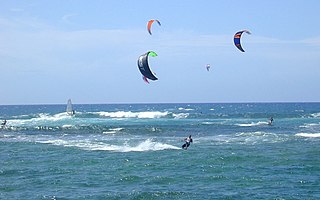
A power kite or traction kite is a large kite designed to provide significant pull to the user.
A Rigid-framed power kite is one of the power kites which consists of a single skin and a rigid frame. They are often used in the popular sport of kite surfing. Typically it has four lines and a pair of handles; or a particular style of bar, again with 4 lines. The best known commercial kite of this type is the Peter Lynn C-Quad.
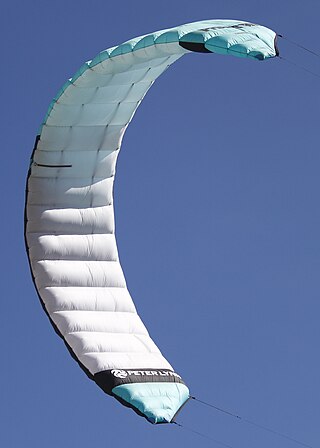
Foil kites are soft kites based on the design of the parafoil. They consist of a number of cells running fore to aft, some or all of which are open at the front to allow air to inflate the kite so it takes on an aerofoil section. Due to the amount of power that these kites can generate, they can be used for a variety of different activities including kitesurfing, kite landboarding, snowkiting, kite buggying, kite-energy systems or airborne wind energy, and recreational kiting.

A leading edge inflatable kite (LEI) is a single skin kite with inflatable bladders providing structure. It is useful as a power or traction kite. These kites are flown using 2, 4 or 5 control lines and a bar. A LEI is a great kite for water use because the inflated bladders cause it to float on the water surface. A LEI can sit on the water for an indefinite time and still be relaunched because, unlike a foil kite, there are no chambers that can fill with water. Generally used for kitesurfing and kiteboarding, leading edge inflatable kites come in many different sizes, most commonly from 5 to 18 square metres.
Kite types, kite mooring, and kite applications result in a variety of kite control systems. Contemporary manufacturers, kite athletes, kite pilots, scientists, and engineers are expanding the possibilities.

A foilboard, also known as a hydrofoil board or foil surfboard, is a type of board used in water sports; it is distinct from surfboards in that it has a hydrofoil rather than fins mounted underneath. This hydrofoil design allows the surfboard and its rider to rise above the water’s surface, allowing for fast speeds and increased maneuverability in a wide range of surf conditions. Foilboards are becoming increasingly popular across many water sports, including surfing, kiteboarding, windsurfing, and wakeboarding. Foilboards have also been used in competitions, with riders reaching speeds of up to 30 km/h while performing acrobatic maneuvers such as flips and twists.

Snowkiting or kite skiing is an outdoor winter sport where people use kite power to glide on snow or ice. The skier uses a kite to give them power over large jumps. The sport is similar to water-based kiteboarding, but with the footwear used in snowboarding or skiing. The principles of using the kite are the same, but in different terrain. In the early days of snowkiting, foil kites were the most common type; nowadays many kiteboarders use inflatable kites. However, since 2013, newly developed racing foil kites seem to dominate speed races and expedition races, like Red Bull Ragnarok and the Vake mini-expedition race. Snowkiting differs from other alpine sports in that it is possible for the snowkiter to travel uphill and downhill with any wind direction. Like kiteboarding, snowkiting can be very hazardous and should be learned and practiced with care. Snowkiting has become more popular in places often associated with skiing and snowboarding, such as Russia, Canada, Iceland, France, Switzerland, Austria, Norway, Sweden, Finland and the Northern and Central United States. The sport has become more diverse as adventurers use kites to travel great distances and sports enthusiasts push the boundaries of freestyle, big air, speed and back country exploration.
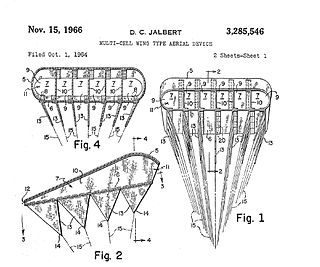
A parafoil is a nonrigid (textile) airfoil with an aerodynamic cell structure which is inflated by the wind. Ram-air inflation forces the parafoil into a classic wing cross-section. Parafoils are most commonly constructed out of ripstop nylon.

Kite landboarding, also known as land kiteboarding or flyboarding, is based on the sport of kitesurfing, where a rider on a surf-style board is pulled over water by a kite. Kite landboarding involves the use of a mountain board or landboard, which is essentially an oversized skateboard with large pneumatic wheels and foot-straps. Kite landboarding is a growing sport, and there are several competitions. Kite landboarding is attracting growing publicity although it is not yet as popular or as well known as kitesurfing.

Bow kites are leading-edge inflatable kites that incorporate a bridle on the leading edge. They are used for the sport of kiteboarding. Bow kites can be identified by a flat, swept-back profile and concave trailing edge, allowing the kite greater depower.

Kites are tethered flying objects which fly by using aerodynamic lift, requiring wind for generation of airflow over the lifting surfaces.

The arckite or twinskin kite is a type of traction kite designed and patented by Peter Lynn. It is a very stable, safe and secure type of powerkite. It can be used for all kinds of kite powered sports, for example: kiteboarding, landboarding, kite buggying or snowkiting. The shape of the kite is similar to a C-shaped leading edge inflatable kite, however the construction is similar to a foil kite. These kites also fall into a category of foils called "closed-cell inflatables", meaning that the ram-air inlets on the leading edge of the kite are normally closed by flaps that act as one-way valves to maintain internal air pressure. It is this feature that makes the kite useful for kitesurfing since, unlike standard open-cell foils, if the kite crashes on the water, it will stay inflated and float long enough for the rider to recover and re-launch.

The International Kiteboarding Association (IKA), is the only kiteboarding class inside the International Sailing Federation (ISAF). The IKA class rules fall in the category of a development class.
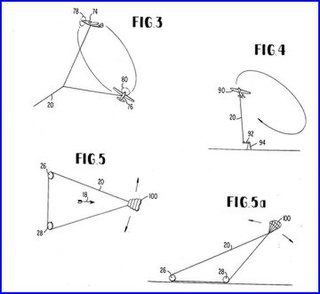
Crosswind kite power is power derived from airborne wind-energy conversion systems or crosswind kite power systems (CWKPS). The kite system is characterized by energy-harvesting parts flying transversely to the direction of the ambient wind, i.e., to crosswind mode; sometimes the entire wing set and tether set are flown in crosswind mode. From toy to power-grid-feeding sizes, these systems may be used as high-altitude wind power (HAWP) devices or low-altitude wind power (LAWP) devices without having to use towers. Flexible wings or rigid wings may be used in the kite system. A tethered wing, flying in crosswind at many times wind speed, harvests wind power from an area that exceeds the wing's total area by many times.

Francisco Lufinha, achieved several world records, namely the Fastest Atlantic Kiteboat Crossing (solo) in 2021 and the Longest Journey Kitesurfing in 2015. He is a completely passioned by nautical sportsman. Taken aboard a boat by his parents only 15 days after he was born, he was never able nor wanted to let go of the sea again.
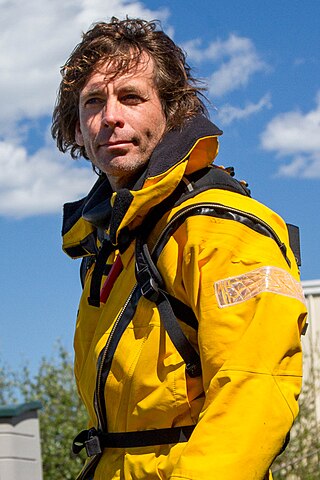
Donald Lewis Montague is a Canadian-American watersport athlete and designer. He is President of Kai Concepts, co-founder of Makani Power, and the head of the Kiteboat Project in Alameda, California.
Kite rigs are wind-assisted propulsion systems for propelling a vehicle. They differ from conventional sails in that they are flown from kite control lines, not supported by masts.

Wing foiling or wing surfing or winging is a wind propelled water sport that developed from kitesurfing, windsurfing and surfing. The sailor, standing on a board, holds directly onto a wing. It generates both upward force and sideways propulsion and thus moves the board across the water. The recent development of foilboards, which plane very early on a hydrofoil fin and thereby lift off the water producing low friction, represent the ideal complementary hydrodynamic platform for wings.















